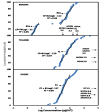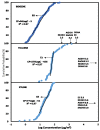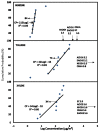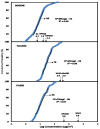Health risk assessment of ambient air concentrations of benzene, toluene and xylene (BTX) in service station environments
- PMID: 24945191
- PMCID: PMC4078583
- DOI: 10.3390/ijerph110606354
Health risk assessment of ambient air concentrations of benzene, toluene and xylene (BTX) in service station environments
Abstract
A comprehensive evaluation of the adverse health effects of human exposures to BTX from service station emissions was carried out using BTX exposure data from the scientific literature. The data was grouped into different scenarios based on activity, location and occupation and plotted as Cumulative Probability Distributions (CPD) plots. Health risk was evaluated for each scenario using the Hazard Quotient (HQ) at 50% (CEXP50) and 95% (CEXP95) exposure levels. HQ50 and HQ95 > 1 were obtained with benzene in the scenario for service station attendants and mechanics repairing petrol dispensing pumps indicating a possible health risk. The risk was minimized for service stations using vapour recovery systems which greatly reduced the benzene exposure levels. HQ50 and HQ95 < 1 were obtained for all other scenarios with benzene suggesting minimal risk for most of the exposed population. However, HQ50 and HQ95 < 1 was also found with toluene and xylene for all scenarios, suggesting minimal health risk. The lifetime excess Cancer Risk (CR) and Overall Risk Probability for cancer on exposure to benzene was calculated for all Scenarios and this was higher amongst service station attendants than any other scenario.
Figures








References
-
- Correa S.M., Arbilla G., Marues M.R.C., Oliveira P.G. The impact of BTEX emissions from gas stations into the atmosphere. Atmos. Pollut. Res. 2011;3 doi: 10.5094/APR.2012.016. - DOI
Publication types
MeSH terms
Substances
LinkOut - more resources
Full Text Sources
Other Literature Sources
Medical

